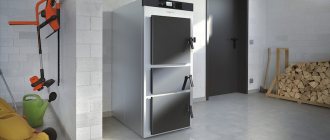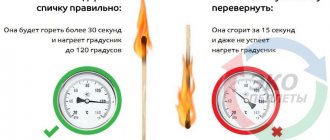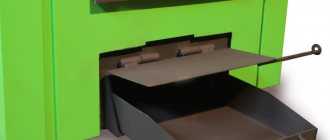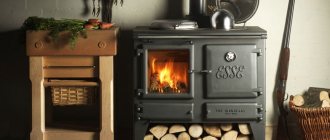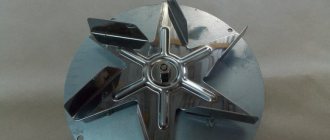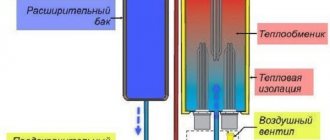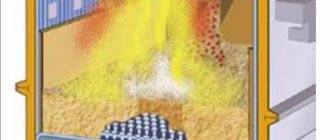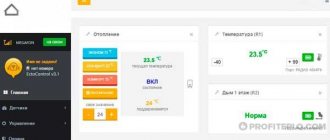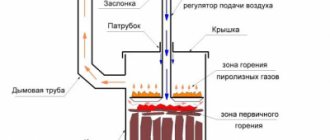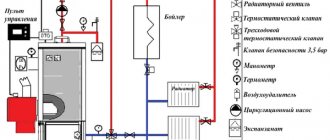Operating principle of a pyrolysis boiler
Pyrolysis is a process with powerful exotherm, in which complex organic matter (in our case, coal, wood, peat, biofuel in the form of pellets, etc.) is decomposed into a simpler composition - solid, liquid and gaseous phases.
For the decomposition process, it is necessary to provide a temperature and limit the supply of oxygen, which is done in a gas generator boiler. To load into the combustion chamber of the boiler, you need fuel that has characteristics that meet the manufacturer’s recommendations, otherwise the expected effect will not occur. Combustion occurs at high temperatures, but at the same time with a lack of oxygen. Wood or coal fuel under such conditions does not burn with a flame, but rather sinteres through pyrolysis decomposition, releasing much more energy than during conventional combustion in air. The main products are solid and volatile fractions (coke oven gas). The unit has two chambers, the upper chamber serves to implement the exothermic reaction of fuel pyrolysis at temperatures from 300⁰С to 800⁰С. The chambers are structurally independent and are separated by grates and regulators - gate valves. The upper gasification chamber, into which fuel is loaded, is sealed and oxygen is in short supply. There is solid fuel on the grate, which creates an obstacle to heat removal; only air passes down into the second chamber, and its flow is weak. The result is slow smoldering and a process of decomposition, or pyrolysis. And the result of pyrolysis is charcoal and pyrolysis, or coke oven gases, CO and, in a small part, carbon dioxide.
The mixture of pyrolysis gas and air is also sent to the lower compartment of the combustion chamber, where temperatures are much higher - up to 1200⁰C, and during combustion it releases heat that is incomparable in quantity to the heat transfer from the combustion of solid fuel in the air. The lower compartment of the second combustion chamber is nothing more than a nozzle-type device made of heat-resistant ceramics or fireclay bricks. Aerodynamics in such a firebox gives high resistance, so draft is realized forcibly by turning on the smoke exhauster. The heat from gas combustion serves for efficient heating of homes. In fact, pyrolysis boilers do not operate on wood or coal, but on emitted gas. The combustion processes of gases are easier to control, so the automation of gas generating units is more advanced.
The solid phase burns very slowly, with a constant release of thermal energy. Volatile coke oven gas also burns, and the heat transfer from this process is somewhat greater than during the combustion of the solid fraction. The efficiency of using firewood and coal increases significantly.
A gas generator unit, despite the simplicity of its design, can be compared to a home laboratory complex that extracts gas from firewood, peat briquettes, coal and other fuels for subsequent combustion with significantly greater heat output.
The design of the pyrolysis unit is considered simple, which is what attracts home craftsmen. To build a boiler, no special equipment is required; the main conditions are the body part with the required parameters, ensuring tightness in the combustion compartment and a strict dosage of incoming air.
With the advent of pyrolysis boilers, classic wood-burning boilers began to be considered obsolete, despite their prices - half the price of pyrolysis boilers with similar power. One load of firewood into a pyrolysis unit provides combustion time and heat supply many times greater than for a conventional solid fuel boiler. New units pay for themselves in a short time. Double-circuit boilers provide even greater savings, since hot water, unlike heating, is required by the home not seasonally, but all year round. Also called a plus is the ability to use wet material for the firebox (up to 40-50% humidity). But dried firewood is more efficient and economical. Wood-burning pyrolysis boilers have gained recognition, among other things, because in many regions and localities dry wood material is inexpensive and often free. Drying wet wood during the summer season is also not a problem, and the consumption for a pyrolysis boiler is very economical.
Operation of “forced” boilers
Supercharging
A computer fan of a conventional design forces air into the gasifier. From the internal air line, secondary air enters the combustion chamber. In this case, the pressure in the working cavity is higher than atmospheric.
Let's consider the advantages of this scheme:
- fan of the simplest design;
- the chamber where the combustion process occurs is combined with an afterburner;
- when using heat-resistant special steels, you can do without lining, because temperatures above 1000 degrees are concentrated near the nozzle, and below 800 - 900 degrees near the walls themselves.
However, all of the listed advantages do not allow us to obtain an efficiency higher than 82-84%. Air under pressure partially envelops the embedded fuel, and the inner part of the fuel, where pyrolysis occurs, receives insufficient oxygen, and increasing the boost will be useless. In addition, there is a lot of air in the chamber itself where the combustion process occurs. The temperature in the core of the torch cannot exceed 1100 degrees, while heavy products do not burn, but evaporate into the pipe. In this case, the efficiency will no longer be higher than 90%.
Particularly noteworthy is the danger of carbon monoxide from a forced-air boiler. Since, if the pressure in the container is greater than atmospheric pressure, then even a microcrack will cause gases to leak into your room. Gases cannot always be identified by smell, but they are always poisonous and corrosive.
Pumping
The pressure in the tract is less than atmospheric. The difference with supercharging is fundamental. In boilers with a smoke exhauster, the fuel supply is well purged: the pressure will be lower where it is more difficult for air to penetrate, but the draft will be stronger. You can bring in secondary air from the outside: its pressure is greater than in the combustion chamber. Therefore, trying to expand, it swirls, mixes with pyrolysis gases and they burn. In this case, the temperature rises to 1200 degrees and above.
As you understand, the efficiency here is increased. It can also be increased due to high temperature and combustion of heavy fractions. It also becomes possible to make a mechanical “oak” thermostat. It is based on a thermobimetallic plate in the hot water circuit, which bends with temperature fluctuations. From it comes a draft to the throttle, which passes outside air into the chimney. When the water overheats, the damper is slightly opened, the motor turns, as before, directly from the network or UPS, but the outside air, with higher pressure, pushes away some of the flue gases. The pressure in the gasifier and combustion chamber increases, less outside air enters there and pyrolysis with combustion subsides.
The efficiency of such boilers with a smoke exhauster can be above 90%, and the power with 100% safety and reliability is 100-150 kW.
You can add fuel to this boiler with a smoke exhauster without any precautions. The door of the loading hatch and the storage area can be opened and closed in any order. In the worst case you will smell an unpleasant odor , but the poisons are not hot.
Features of pyrolysis boilers
Traditional wood-burning boilers are annoying because they require constant monitoring. That is, every 2-3 hours you need to add more and more fuel to them, otherwise the pipes in the house will become cold. It’s especially difficult at night, when instead of restful sleep, household members get a headache in the form of cooling heating. On the one hand, sleeping cool is good for your health. On the other hand, greeting the morning with your teeth chattering desperately is not very pleasant.
Classic boilers for heating a home have another important drawback - low efficiency. The fuel in them burns very quickly, most of the heat simply evaporates into the atmosphere. Along with it, combustion products containing flammable gases fly into the air. They can be used to obtain additional portions of heat - this is what happens in long-term combustion pyrolysis boilers.
As you already understand, solid fuel pyrolysis heating boilers are free from both of the above disadvantages. They are equipped with spacious fireboxes, burning solid fuel according to a slightly different principle. Here are their main features:
The operating principle of a solid fuel pyrolysis boiler is very simple. This drawing, although it does not cover all the nuances, conveys the essence of the technology in full.
- Large firebox volume – up to several tens of liters. Thanks to this, the frequency of approaches to laying fuel is reduced several times;
- Pyrolysis combustion principle - allows you to get much more thermal energy from the same amount of firewood;
- Quite large in size - in fact there are two fireboxes. In one, wood burns slowly, and in the second, combustion products released from the wood are burned;
- Low combustion temperature – reduces the thermal load on the metal.
Long-burning pyrolysis boilers are somewhat more complicated than their traditional counterparts, but they provide significant fuel savings.
It should be understood that due to their complex design, which often contains elements of automation, pyrolysis boilers have a high price. Therefore, the initial cost of purchasing them may seem large. But in the future they will definitely justify themselves.
Manufacturing nuances
From the above, it becomes clear that many complex chemical processes will take place inside the future home-made boiler, and the efficiency and safety of the unit will depend on how correctly they are carried out. Therefore, if a choice has been made in favor of developing the circuit and assembling a home-made unit, this process must be taken with great responsibility.
There are two options to solve this situation:
- Buy drawings with step-by-step assembly instructions from manufacturers or people who have good experience in the design, manufacture and testing of gas-generating boilers.
- Take up books and modeling programs yourself to develop a design and drawings for a pyrolysis boiler.

When designing, working out step-by-step instructions, as well as manufacturing, you need to take into account the following features:
- The material from which the gasification, combustion and post-combustion chambers will be made must be steel with a heat-resistant lining . The reason for this is 1000 °C inside the combustion chamber. If you use standard sheet steel, it will burn out in two or three seasons. According to many videos, it most often burns out under the combustion and afterburning chambers.
- It is better to make a water heat exchanger . Although it is more complex because it requires the manufacture of two containers that are connected by a system of pipes, it is more reliable and lasts longer. As for the fire tube heat exchanger, it lasts less, because the pipes must be heated to a temperature of more than 600 ° C. Such heating leads to rapid burnout. People choose such heat exchangers because they are easier to manufacture, because they represent one water container with a small number of vertical tubes placed inside it.
- The heat exchanger is placed only in the rear chamber . It should not be placed in chambers where fuel burns. This is because it will absorb heat, which will disrupt the processes of pyrolysis and combustion of gases. The efficiency will become less.
- Cameras should be made round or rounded. If the design of the pyrolysis boiler includes rectangular containers, then the efficiency will be lower, because that part of the heat that disperses to the corners will simply disappear without giving any benefit. Moreover, such a leak will reduce the temperature in all chambers and disrupt the processes that occur in them. The ideal cameras are round. They look like a barrel placed on its side.
- The nozzles also need to be made round. Ideally, they should be in the shape of a circle. However, such holes quickly become contaminated with ash and need to be cleaned. The latter process damages the lining. Therefore, it is worth choosing a nozzle with a slit that runs through the entire length of the bottom . Due to this solution, the efficiency does not drop very much - up to 3%.
Secrets of developing a pyrolysis boiler
DIY pyrolysis furnace diagram.
In order for the boiler device to be brought to ideal condition, it is advisable to perform certain actions. An adjustable boost fan can be installed under the fuel tank. It is designed to pump air directly into the boiler itself. Under the influence of artificially pumped air, accelerated combustion of fuel occurs. All this work can be done with your own hands. Installation of this equipment does not require any special skills.
To increase the amount of heat generated, the automation must work smoothly and accurately, the fuel bunkers must be in optimal positions.
It is possible to achieve an extension of the fuel combustion period if, when constructing a boiler with your own hands, the fuel chambers are separated. In this case, fuel will be burned in one of them, and gases will be collected in the other. When using a two-zone gasification system, it is possible to achieve energy independence of the boiler and a constantly high level of power. The power of a wood-burning stove can be increased by placing grates at the bottom of the fuel bunkers.
A high-quality heat storage device in pyrolysis boilers (as opposed to coal-fired devices) is to install a jumper directly in the combustion chamber. In this case, automation performs its direct function.
The design of the pyrolysis boiler is designed in such a way that there is no need to chop firewood before feeding fuel into it - the main thing is that it can pass through the stove door.
Wood-burning pyrolysis boilers can operate and produce greater thermal energy when using sawdust and peat briquettes. Some boilers can even operate on coal. Installing such a boiler will not require much effort and time. The main thing is to correctly understand the principle of its operation and create a high-quality chimney
It is very important that the chimney has sufficient draft to blow out residual gases. It is not difficult to do it yourself. https://www.youtube.com/embed/uKshq2tUe84
Operating modes of a gas generator boiler
All pyrolysis boilers operate in three modes:
Additional fuel loading should be carried out quickly to avoid filling the air with carbon monoxide and heat losses.
How do pyrolysis boilers work?
The operating principle of a pyrolysis boiler is to generate combustible gases and then burn them. In order to understand how it works, we should recall an interesting experience from a school physics textbook. There it was proposed to enclose some wood chips in a glass flask, plugged with a stopper with a thin tube. The flask was placed under the burner, after some time the pyrolysis reaction began in it. After this, flammable gases began to emerge from the tube, which were easily ignited and burned with a bright flame.
The operating principle of a pyrolysis boiler is based on a similar reaction, only on a larger scale. There are two cameras involved here:
- Combustion chamber - the fuel is pre-ignited in it, after which the firewood is in a slow smoldering mode, with limited air access;
- Afterburner chamber - pyrolysis products burn here, generating heat that is sent to the fire tube heat exchanger.
This entire facility is cooled by a water jacket.
Studying the principle of operation of a pyrolysis boiler, it may seem to you that the effectiveness of this technique is extremely low. In fact, a lot of gases are released. If we look into the afterburning chamber, we will see a powerful roaring flame there, releasing a wild amount of thermal energy.
Combustion chambers in pyrolysis boilers can be located in any sequence. For example, one above the other or sequentially, one after another. There are also units in which afterburning is carried out under the main firebox. The combustion intensity is adjusted using a blower fan or using the blower door. It should be noted that the adjustment range is quite large - if necessary, the flame can be extinguished almost completely.
The operating principle of the pyrolysis boiler involves preliminary ignition of wood fuel. We need the wood to be well ignited. To do this, the throttle valve and the blower are opened, and a portion of firewood with small splinters for ignition is placed in the firebox. We set it on fire and wait for a stable fire to appear. Now our pyrolysis boiler is ready for full launch. We perform the following actions:
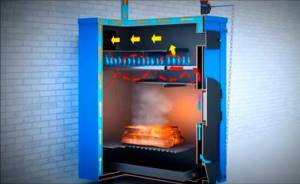
Thanks to the design of the pyrolysis boiler, hot air does not fly out into the chimney immediately, but first passes through a special compartment. This allows the system to significantly increase its efficiency compared to conventional boilers.
- Close the throttle valve;
- Close the blower door;
- Turn on automation;
- We observe the temperature increase in the system.
Let's take a look at how a pyrolysis boiler works inside - there's a lot of interesting stuff going on here. Firstly, after cutting off the supply of oxygen, our cheerful flame turns into smoldering embers. And secondly, after the automation is started, the blower fan turns on, the pyrolysis products are sent to the afterburning chamber, where a powerful flame begins to rage. This operating principle is implemented in all pyrolysis boilers. The only differences are in the adjustment scheme - in some places electronics are responsible for automatic adjustment, and in others simple mechanics.
Device

The huge chamber is designed for storing solid fuel: coal, firewood and other flammable substances. Firewood or other fuel flares up, then the air is automatically shut off. For the flame to be intense, air is needed. There is not enough oxygen for intense combustion, and the wood begins to smolder. Wood gas and a lot of carbon are released - ash particles. Air and ash particles are mixed in another chamber and the afterburning process occurs. Both chambers are separated by a special grid on which fuel is stored. The peculiarity of fire in such a device is that it has a reddish tint due to the reaction with carbon.
Advantages and disadvantages of pyrolysis boilers
Like other heating equipment, pyrolysis boilers have pros and cons according to various criteria.
The disadvantages of long-burning boilers mainly lie in their cost. Such equipment is several times more expensive than classic direct combustion devices.
Unlike standard boilers, pyrolysis boilers require less fuel in order to maintain the room temperature for a long time.
Another advantage is the small amount of waste.
When organic matter burns for a long time, virtually no ash remains.
The disadvantages also include high requirements for the moisture content of firewood. This threshold should not be higher than 20%, otherwise they will not be able to burn and release gas.
Brief overview of famous brands
The German companies BUDERUS and VIESSMANN are considered generally recognized leaders in the production of the best pyrolysis boilers. They are distinguished by high quality materials and workmanship, operational reliability and compliance with all technical indicators stated in the passport. The installations are fully automated, including the ignition process. The Vitoligno 100-S modification from VIESSMANN, which runs on solid fuel, has the following characteristics:
- the range of units includes several models in the power range of 25–80 kW;
- The efficiency of the installations is 88%;
- working pressure – no higher than 3 Bar;
- temperature in the supply / return pipeline – 95 / 55 ⁰С;
- The maximum length of wood loaded into the firebox is 0.5 m.
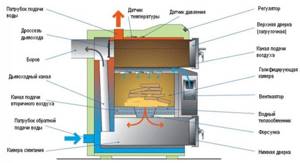
Construction of a long-burning pyrolysis boiler
Automation for the Vitoligno 100-S pyrolysis boiler includes a set of sensors and a controller. The fan to create draft does not work as a blower, but as a smoke exhauster and is located in the chimney duct. During operation, the Vitotronic 100 FC1 controller can not only control the fan, but also three-way boiler valves, circulation pumps and mains pumps.
The technical characteristics of long-burning pyrolysis boilers from BUDERUS are also impressive:
- line of models in the power range of 20–40 kW;
- Efficiency – 88-90%;
- working pressure – 3 Bar;
- supply / return temperature – 95 / 55 ⁰С;
- maximum length of firewood is 0.58 m.
Buderus pyrolysis boilers
Solid fuel models Logano G221 and Logano S121–2 are equipped with a fan - smoke exhauster, a Logamatic control unit and sensors. The automation functions are the same as those of VIESSMANN. The peculiarity of BUDERUS products is their remarkable appearance, which cannot be confused with anything else. In addition, the company produces not only steel, but also cast iron pyrolysis boilers (model Logano G221). The products of both companies are quite expensive, as well as how well they are made and reliable in operation.
Among the manufacturers of boiler systems in the mid-price category, the fairly widespread Czech brand VIADRUS and its model Hefaistos P1 should be noted. The manufacturer declares the acceptable parameters of its product, despite the fact that its cost is significantly lower than the “Germans”. Operating practice shows that you can buy units from this company and others in the mid-price category for your home; they work quite satisfactorily.
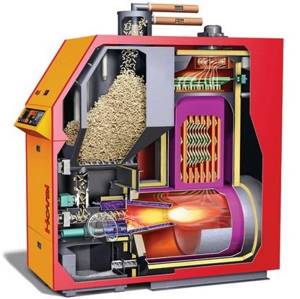
Pyrolysis boilers using pellets
It is most comfortable to operate pyrolysis boilers using pellets. The convenience is that you don’t need to load the firebox at all. It is enough to fill the bunker with pellets once a week; this interval depends on the capacity of the bunker. From there, a screw conveyor supplies fuel to the pellet burner through a corrugated plastic pipe. The entire process is fully automated, and PellTech burners have a built-in automatic fire extinguishing sprinkler system to which water is supplied.
Tools and materials
To install such a unit on your own, you will need the following set of tools and materials:
- Thermal sensor.
- Fan.
- Steel strips of various thicknesses and widths.
- A set of professional pipes with a diameter of 2 mm.
- Metal sheets 4mm thick.
- A set of pipes of various diameters.
- Cutting wheel with a diameter of 230 mm.
- Grinding wheel with a diameter of 125 mm.
- Hand-held circular saw (grinder).
- Several packs of electrodes.
- Welding machine.
- Electric drill.
If you plan to make a pyrolysis boiler yourself, then the recommended steel thickness should be 4 mm. To save money, you can use 3 mm thick steel. To make the device's body, you will need durable steel that can withstand high temperatures.
How to make a pyrolysis boiler with your own hands
The technological process of manufacturing a boiler based on the pyrolysis operating principle includes plumbing and welding work.
Required materials and tools
To manufacture a high-quality unit, experience in working with the following tools is required:
- electric welding machine;
- electric drill;
- Angle Grinder;
- set of plumbing tools - square, level.
Materials and components required:
- metal: sheet, thickness 4 mm, 7.5 m²;
- pipe - 8 m (diameter 57 mm, wall thickness 3.5 mm);
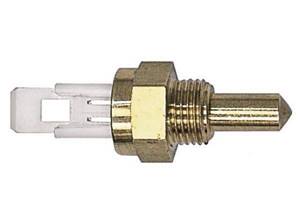
A temperature sensor is a mechanical device for monitoring the amount of air passing into the combustion chamber.
The productivity of the boiler depends on the functioning of the chimney. To ensure good draft, the chimney must meet the quality requirements:
- height not less than 5 meters;
- good insulation;
- no sharp bends;
- condensate drainage;
- easy access for cleaning.
Device drawings and diagrams
A pyrolysis boiler without forced ventilation has the simplest design. The non-volatility of the design reduces the cost of operating the unit.
The diagram of a pyrolysis boiler with a natural smoke exhaust looks like this:

To increase high efficiency, some designs have double base walls
The boiler consists of three main chambers:
- loading room, used for adding fuel;
- an afterburner chamber where secondary air is supplied;
- heat exchanger exiting into the pipe.
The combustion of raw materials directs the gas flow from top to bottom. When air is supplied under the grate into the fireclay brick array, flammable gases are burned. The decomposition products go through the heat exchanger into the chimney. The draft is adjusted by a temperature sensor at the boiler outlet using a chain connected to the secondary air supply damper.
Detailed details with dimensions and tolerances can be found in the standard drawing:

A - boiler circuit controller; B - loading door; C—ash pan cover; D - smoke exhaust; E - coupling for temperature fuse sensor; F - safety valve pipe; G—circuit supply line; H - cold water supply to the heat exchanger; L - return line of the boiler circuit; M - expansion tank
Step-by-step instructions for manufacturing the unit
Making a pyrolysis boiler with your own hands is divided into stages:
- According to the drawing, parts for the body are marked and cut. After “sticking” the elements, a control measurement is made, then welding seams are made. Once in place, the back panel and side walls are welded on both sides, cleaned, and treated with welding sealant.
- The heat exchanger pipes are being installed.
- After welding the outer wall and door shells, a mechanical coolant control regulator is installed.
- The chimney is assembled by extending the pipe. The next part must be inserted inside the previous one so that condensation does not fall on the outside. The finished structure is painted with fireproof paint.
Advantages and disadvantages
The advantages of such an installation include:
- The highest efficiency among all solid fuel boilers, it is 90–93%.
- About 3 times less harmful substances are released, which makes them more environmentally friendly.
- Large interval between fuel loadings, about 12 hours for soft wood and 24 hours for briquettes, pellets and hard wood.
- The low amount of tar in the exhaust gases extends the service life of chimneys.
Flaws:
- Requires low moisture fuel. The best option is 20%.
- The cost of such boilers is higher than all other types of such equipment.
- The forced draft installation makes it dependent on electricity.
How does wood humidity affect efficiency?
Wood for pyrolysis boilers must be dried to 15-20% humidity. This result is difficult to obtain with natural drying, so this can be considered the main disadvantage of this type of boiler.
Wet firewood releases more water vapor, which mixes with the gas-oxygen mixture and reduces its energy intensity. An example of such a reduction in numbers:
- Burning 1 kg of wood with a humidity of 20% - power 4 kW;
- Burning 1 kg of wood with a humidity of 50% - power 2 kW.
Choosing a boiler manufacturer
In general, today German companies are considered market leaders. These are companies such as Viessmann or Buderus. High-quality models are relatively expensive, but they are distinguished by the highest performance. Good efficiency allows you to “refuel” the boiler approximately once a day, which significantly saves your time and effort. Fuel costs in these boilers are also reduced, and heat is distributed more evenly throughout the house. Moreover, high-quality German models often also have many automatic modes, which sometimes make life even more significantly easier.
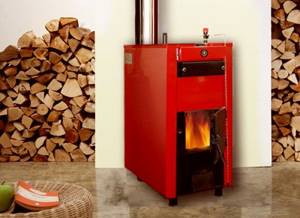
If you don’t have enough money for a model with German precision, we advise you to save money and buy one of the Czech-made boilers.
For example, Dakon has long established itself as a leader in the line of budget manufacturers. The design of the boilers of this company is not much different from the German ones, they work almost as reliably, and at the same time they are much cheaper. Of course, they ultimately last less, and they cannot boast of such high efficiency, but they still allow you to save money. One of the latest models from the company is called Daman Pyro - it has built-in fans for uniform gas supply, while allowing you to adjust the operating power, which is especially useful during periods of warming. The body of the model is cast iron, which ensures durability.
Pyrolysis boiler - manufacturing scheme, main stages
To assemble a gas generator heating unit yourself, you must adhere to the following requirements:
The necessary elements should be cut using a grinder. The fuel loading hole is located slightly higher than that of solid fuel devices. To control the amount of air entering the combustion chamber, it is necessary to install a limiter. It can be made using a pipe with a diameter of 70 mm, and the length should be slightly longer than the boiler body. Using a welding machine, a steel disk is welded, which, together with the walls of the pipe, should form a gap of approximately 40 mm. To install a limiter in the boiler lid, you need to make a corresponding hole. It should have a rectangular shape. The hole is closed by a door equipped with a steel plate. This will ensure a secure fit. Below is a hole designed to remove water. Using a pipe bender, it is necessary to bend the pipe intended to move the coolant inside the boiler. This ensures maximum heat transfer. The amount of coolant sent to the device can be regulated by means of a valve mounted externally. As soon as the equipment is started for the first time, there should be no carbon monoxide in the combustion products. If this condition is met, the piping of the pyrolysis boiler (the diagram is indicated) is done correctly
It is important to regularly monitor the condition of the device’s welds and promptly remove any soot and ash that has formed from it.
An excellent option would be to combine a pyrolysis boiler not with classic water heating, but with air heating systems. As a result, air will be transferred through pipelines, and its return to the system will be through the floor. Such a system has numerous advantages: it does not freeze in severe frosts, and there is no need to drain the coolant when the owner leaves.
Do-it-yourself pyrolysis boiler manufacturing and safety rules
to menu
Safety rules during the manufacture of a pyrolysis boiler
- use gloves during work;
- when welding, wear a protective helmet;
- When using power tools, maintain a distance of at least 50cm;
- store structural parts in a protected place - away from children and animals;
- do not look at welding with the naked eye;
- The boiler room must be isolated from surrounding factors. It is necessary to install a ventilation system in it;
- The walls and foundation of the boiler must consist of heat-absorbing materials.
to menu
Safety rules for operating a homemade pyrolysis boiler
- do not lean your body against the boiler;
- use gloves when operating the device;
- do not forget to add water;
- do not leave chambers open for storing firewood and slag;
- do not install any structures near the unit, especially those made of wood;
- when removing toxins, use a spatula;
- Do not put unprotected hands into the boiler chambers.

Pyrolysis boiler in the heating system
to menu
Device and purpose
A pyrolysis boiler for heating a private home operates by burning fuel at a very high temperature and with limited air access. Instead of solid fuel, a new one is actually created - special gas. It is additionally burned in a special chamber, which is usually located below the solid substance intended for loading. Accordingly, air is pumped first into the upper part, and from there it enters the lower chamber. Since this contradicts the laws of physics, they have to be overcome artificially, using fans or pumps.
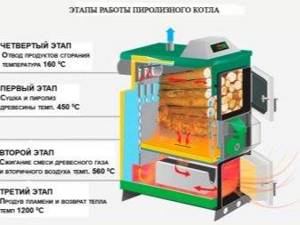
The lack of oxygen in the air used helps make combustion more prolonged than in conventional boilers or furnaces. It is possible to extend the heat release time from one portion of firewood, for example, up to 20 hours. Miracles, of course, do not happen: they give off thermal energy in small portions. But for a greenhouse, such a solution is even a plus, because it allows you to maintain a stable temperature without overheating and hypothermia.
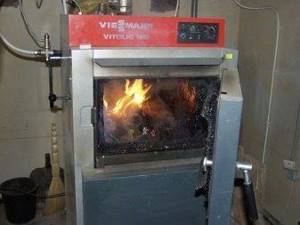
The use of a pyrolysis boiler for a bath deserves a separate discussion. It turns out to be more practical than both gas and electric heating devices. In terms of efficiency and convenience, it is ahead of many stoves, especially when compared with homemade designs. Any pyrolysis boiler has a horizontal segment (the so-called “hog”), which is designed to connect the structure to the chimney. The wall thickness in this place is 4.5 mm, and the usual length reaches 50 cm.

The characteristics of a pyrolysis boiler make it possible to consider the increased cost (compared to simple solid fuel alternatives) to be quite appropriate in most cases. The time it takes to use one load of fuel is difficult to predict in advance; it depends on a large number of factors. In technical documentation and popular descriptions, the minimum and maximum possible figures are usually given.
They are affected by:
- humidity of the fuel used;
- temperature in the house and outside;
- quality of insulation;
- features of the heating system.

Dry distillation is regulated using a nozzle that doses the supply of atmospheric air
What is important is that boilers operating on the principle of pyrolysis are capable of drying wood or coal reserves stored in the same room. Features of the operating mode exclude the entry into living spaces of not only carbon monoxide or carbon monoxide, but also safer water vapor
Most designs work best with very well-seasoned wood.

Review of popular models
It should be understood that any pyrolysis boiler is a fairly heavy unit that is not intended for hanging on the wall. Such devices can be used both for heating a small house and spacious cottages. Like other heating units, long-burning boilers vary in power.

When choosing a pyrolysis combustion boiler, you should focus on such indicators as the thermal power of the device, the size of the loading chamber, the presence of a secondary circuit, etc.
Buyers usually focus on this indicator.
Among the popular models of such equipment we should mention:
- Atmos (Ukraine) - presented by devices that can operate on both wood and coal, power varies from 14 to 75 kilowatts.
- Attack (Slovakia) - capable of heating areas up to 950 sq. m, some models are able to continue working even during power outages.
- Bosch (Germany) - high-quality products from a well-known brand, power varies between 21-38 kilowatts.
- Buderus (Germany) is represented by the Elektromet and Logano , the first is well known in Europe as a classic version of a pyrolysis boiler, the second - more modern versions intended for private homes.
- Gefest (Ukraine) – high-power devices with efficiency up to 95%.
- KT-2E (Russia) is specially designed for large residential premises, the unit power is 95 kilowatts.
- Opop (Czech Republic) - relatively inexpensive boilers, reliable and durable, power 25-45 kilowatts.
- Stropuva (made in Lithuania or Ukraine) with a power of seven kilowatts or more are quite suitable for a small home, but the model range also includes more powerful devices.
- Viessmann (Germany) is an ideal choice for private households, power starts from 12 kilowatts, the use of modern technologies allows you to save fuel.
- “Buran” (Ukraine) with a power of up to 40 kilowatts is another popular option for owners of large cottages.
- “Logika” (Poland) high-power devices of 20 kilowatts easily heat rooms up to 2 thousand square meters. m, it is more of a boiler for industrial needs: heating workshops, offices, greenhouses, etc.
When choosing a pyrolysis boiler for a private home, you should pay attention to models with two circuits, in order not only to heat the home, but also to provide it with an autonomous hot water supply.
The heat exchanger for hot water supply can be storage or flow type. For the latter option, boiler models with increased thermal power are used.
If you want to save money, you can try making a pyrolysis boiler with your own hands. The technology for its assembly is described in this article.
Principle of operation
The boiler runs on solid fuel, usually wood, peat, lumber waste, special wood briquettes, coal and pellets (pellets made from crushed wood, resin, pine needles, etc.). Particularly popular are universal-type devices that can consume almost all types of solid fuel.
According to the method of heat transfer, boilers are:
- Air.
- Steam.
- Water (found most often).
According to the principle of fuel combustion:
- Traditional. They work on wood and coal. The operating principle is the same as that of a conventional wood stove.
- Long burning. Innovative development in the field of heating equipment. Long-burning solid fuel boilers have the form of an elongated combustion chamber surrounded on all sides by a water jacket. When burning, the flame spreads not from bottom to top, but from top to bottom, reminiscent in this respect of the process of burning a candle. The operating principle of a long-burning boiler allows complete combustion of fuel to be achieved. At the same time, the combustion interval of one load of fuel increases (up to 7 days). A long-burning boiler operates, as a rule, at a consistently high coolant temperature, which increases its efficiency by an order of magnitude. The uninterrupted and safe operation of such models is achieved by incorporating fans for emergency extinguishing, a safety valve and a circulation pump into the design.
- Pellet. Special pellets are used as fuel here. Such boilers are additionally equipped with an automatic pellet supply system and a fuel storage bunker. Thanks to electronic sensors, the presence of fuel inside the firebox is monitored. To operate such a system, a stable electrical supply is required.
- Pyrolysis. Unique equipment where, along with the energy from the combustion of solid fuel, the heat release of gases is also used. This makes it possible to convert a small amount of fuel into a significant portion of thermal energy. As a result, an increase in boiler efficiency and a reduction in harmful emissions is achieved.
Materials and fuel
Both the buyer and those who decide to design the boiler themselves need to know that the combustion chambers, gasifier and afterburner will not work for long without temperature-resistant protection. The application technology and composition of the protection is a special secret of any company engaged in the production of boilers.
The most preferred types of solid fuel for these boilers are firewood or fuel pellets (industrial models are designed for them). A coal-fired pyro boiler with high efficiency will operate until all volatiles are released. And there are not so many of them in coal, and in charcoal there are almost none. After this, carbon combustion occurs with an efficiency coefficient that corresponds to that of a stove. An efficient boiler designed for long-term combustion on coal must be designed for a combined operating cycle. In this cycle, the embedded fuel burns from the surface, and the pyrolysis cycle occurs with combustion directly on the surface of the fuel.
Design and principle of operation of the boiler

The primary combustion chamber or pyrolysis chamber resembles in its design the firebox of a conventional furnace. Solid fuel (firewood, sawdust, wood or peat briquettes, pellet granules) is placed through the loading window onto a massive fire-resistant grate - a grate, which provides an influx of air to the fuel, which is called primary.
Operating principle of a long-burning boiler
Pyrolysis gas is forced, less often by gravity, into a secondary chamber - a combustion chamber or afterburning chamber, into which a sufficient amount of air is supplied, which is called secondary. Upon contact with oxygen, gas heated to high temperatures (more than 300 degrees Celsius) instantly flares up and burns, releasing a large amount of heat. The main function of the boiler is performed - heating the coolant.
The operating principle of the pyrolysis boiler is shown in detail in the video.
The air is usually forced by a small fan. Although in small models sometimes a smoke exhauster is used to create draft.
This diagram shows the structure of a bottom combustion pyrolysis boiler. Firewood burns slowly with little oxygen and releases flammable gas ( )
The presence of forced ventilation can be considered the main difference between a pyrolysis boiler and a classic solid fuel model. The device body consists of two parts inserted into each other. The space between the walls is filled with a coolant, the role of which is traditionally played by water.
The combustion temperature can reach 1200°C. The water in the external heat exchanger is heated and circulated through the heating system of the house. Remains of combustion products are removed through the chimney.
Devices that use the pyrolysis combustion principle can be reproached with a relatively high price. A conventional solid fuel boiler costs significantly less. But in long-burning boilers, wood burns almost completely, which cannot be said about a classic boiler.
Firewood for a pyrolysis boiler has certain requirements in terms of size and humidity. Detailed information can be found in the manufacturer's instructions
When choosing a pyrolysis boiler, you should remember that inexpensive low-power models are usually designed only for firewood. Expensive modifications can operate on different types of fuel.
According to the method of fuel combustion, long-burning boilers with a double circuit can be divided into:
- Pyrolysis. Equipped with two combustion chambers. In one of them, the process of smoldering and the release of gas for pyrolysis occurs, in the other, the resulting gas is mixed with oxygen and burned. Equipment of this type is characterized by high environmental friendliness - a minimal amount of harmful substances is released into the atmosphere. The combustion process produces little soot. If the boiler is equipped with automation, power adjustment will be possible.
- With upper combustion chamber. Such boilers are very easy to maintain. The amount of automation required for their stable operation is minimal; it is possible to operate in autonomous mode without electricity. There are also disadvantages - a lot of ash is generated during operation, there is a list of requirements for fuel types. For example, small wood chips or sawdust are not suitable for kindling.
- Pellet. To kindle such equipment, special pellets or compressed fuel briquettes are used. Such boilers are environmentally friendly, economical and efficient, and have a long service life. One of the main disadvantages is the high price of the boiler and the special conditions that will have to be maintained for fuel storage. The room should be dry; high air humidity will contribute to the deterioration of pellets.
What fuel to use
For economical and efficient operation of the pyrolysis boiler, you can use any solid fuel: firewood, coal, peat, pellets, and other combustible materials. The main condition necessary to maintain the pyrolysis combustion process is low humidity, no more than 20%. Wetter fuel must be specially dried to the required level. The ability to use waste from wood, clothing, oil mills and other types of production makes this oven even more profitable to use. The wood content must be at least 70%.

To operate a pyrolysis boiler, it is recommended to choose solid fuel
In conventional stoves, firewood needs to be added every two to three hours. Approximately 10 cubic meters of firewood are consumed in the winter. In pyrolysis boilers, wood burning lasts 12 hours, saving up to 40% over the winter. Coal burns much longer, up to five days, which saves not only fuel, but also time. There are models that are equipped with automatic feeding of fuel pellets, that is, they work in autonomous mode for a long time.
Advantages and disadvantages
It is not enough to study the reviews of owners and specialists on specific models, and to get acquainted with the ratings of the best modifications. The most important question must also be answered: how do the advantages and disadvantages of pyrolysis boilers compare, and whether they actually justify the investment. And here there cannot be a universal answer, because a lot depends on priorities and on the specifics of the equipment’s use.
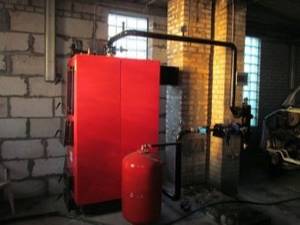
Any pyrolysis boiler, due to its design features, has built-in automation. Working for many hours at one gas station frees up a lot of time and energy. Almost any wood processing and harvesting waste, and sometimes not only them, can be used as fuel.
The flip side of these advantages are:
- attachment to the operation of the electrical network;
- mandatory installation of uninterruptible power supplies;
- unsuitability of raw wood;
- inability to supply water colder than 60 degrees to the heating circuit (it accelerates corrosion);
- the inability to automate the fuel loading itself (feeding from the bunker only makes manual work less frequent, but does not eliminate it completely);
- the need for lining with fireclay bricks;
- increased cost compared to simple solid fuel devices.
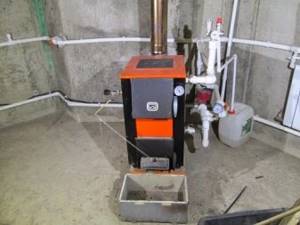
Double-circuit boilers
A do-it-yourself double-circuit pyrolysis boiler is the right choice, because a heating system without hot water supply is a kind of nonsense.
Features of the manufacture of a double-circuit heating device are as follows:
- The DHW circuit is supplemented with a storage tank . It is worth abandoning a full-flow circuit because without expensive automation, the water in it can boil, which can cause the entire hot water system to explode.
- The circulation in the second circuit and hot water supply should be thermosiphon. Thanks to this, the coolant will constantly move through the system and cool . In addition, when the electricity disappears, hot water will still flow from the tap.
The coil (second circuit) is built into that part of the heating circuit where the water temperature does not exceed 80-90 °C. And it is observed at the feed exit. True, to implement this option it is necessary that the system not be drained, and also have a membrane expansion tank . The DHW heat exchanger can also be placed in the compartment, which is made at the top of the partition between the firebox and the heat exchange chamber. True, the volume of such a circuit should be large. Its dimensions are calculated so that its 5 liters or more are per 1 kW of boiler power.
Pyrolysis as a long-term combustion process
In a nutshell, pyrolysis is the slow burning of fuel to produce products that are again used to generate heat. The isolated atoms do not mix with each other and represent a combustible substance ready for use. The essence of combustion is a minimal supply of oxygen to maintain the smoldering of briquettes or firewood, but also a large production of thermal energy. Saving is the main advantage of the unit.
Advantages of a pyrolysis boiler
The pyrolysis boiler also has the following advantages:
- High efficiency - efficiency factor. From 85% is an excellent indicator, indicating that fuel energy is converted into heat energy with virtually no residue. For comparison, a gas boiler generates 65% of the energy.
- A boiler or pyrolysis furnace are economical units. In terms of fuel and money spent, they are in second place after the gas generator. And, of course, they are not comparable to electric boilers.
- The units process fuel in two stages - burning wood and using the released gas. The provided container for accumulating flammable gas allows you to arrange a second heating circuit with the generation of hot water for your own needs.
- Do-it-yourself long-burning boiler is a common thing, since the design is simple and you only need to have welding skills. Drawings and diagrams can be found on any network portal, as well as reviews of homemade designs.
- A do-it-yourself, long-burning solid fuel boiler that you assembled yourself does not require a permit, like gas and electric boilers. But you should not refuse the recommendations of master installers - these are, after all, high-risk units, but assembly and installation at a specific location remains the prerogative of the owner, which does not require him to make material investments in fulfilling the letter of the law.
- The time for complete combustion of one portion of fuel reaches several days. For example, a long-burning boiler for up to 7 days is a common case. This frees the owner from constant control over the unit, and its own automatic settings will allow you to leave the house with a working stove.
Homemade pyrolysis boiler: drawings, calculations, adjustment, video
Pyrolysis boilers have long gained popularity among owners of private houses - in terms of efficiency, they are close to gas equipment, and can be installed even in any home and do not depend on the availability of gas and electricity. You can make a pyrolysis boiler yourself, saving a lot of money.
Differences and advantages
In conventional wood-burning boilers and water-heated stoves, wood burns quite quickly, and one load of wood lasts for 3-4 hours.
Heating equipment requires constant attention, because if the fire in the firebox goes out, the coolant will cool down and the house will become cold.
This feature of solid fuel boilers often forces homeowners to install additional electric heating or install a long-burning boiler.
Pyrolysis boilers are characterized by a long operating time on one load. They can use firewood or pellets—pressed wood waste—as fuel. The duration of operation of such models is due to a special operating mode based on pyrolysis.
: boiler operating principle
Pyrolysis - what is it and how is it used in boilers
The process of burning wood is quite complicated. It consists of cellulose fibers held together by a binder - lysine.
When heated, these bonds are destroyed, and gas begins to be released, and the wood fibers begin to darken and char. The gas, called pyrolysis gas, contains flammable elements, including hydrogen.
Heated by the hot surface of a smoldering log, it ignites and forms a bright fire.
Increased oxygen content in the combustion zone increases the size of the flame. This can be noticed when opening the firebox door - the wood immediately begins to burn brighter.
The combustion of pyrolysis gases is accompanied by an active release of heat, which intensifies the smoldering of the wood, and very soon it burns down to coals.
The flame can reach a height of more than a meter, and not only the stove, but also the chimney heats up, and hot, not completely burned gases with a high soot content escape into the chimney.
The design of the pyrolysis boiler allows combustion of flue gases in a separate afterburning zone. At the same time, the firewood in the gas generation zone smolders for a long time and evenly, with a constant temperature.
To avoid active combustion of fuel, the flow of air into the loading chamber is limited using a damper.
On the contrary, air is pumped into the gas afterburning zone, sometimes using a fan, but more often using natural draft.
Design
Externally, a pyrolysis type boiler is not very different from its solid fuel counterpart. In a steel or cast iron body there is a firebox equipped with a door or hatch for loading fuel. The firebox can be divided into gas generation and afterburning chambers using partitions, but sometimes the division is conditional, and the processes occur in different zones of the firebox.
To clean ash, there is a grate at the bottom of the fuel loading chamber, and below there is an ash pan with a door or a box for collecting ash. The afterburning zone is also equipped with a separate door for cleaning, since soot often forms in it and requires cleaning.
Next to the firebox there is a heat exchanger through which the coolant selected for the heating system circulates: antifreeze, antifreeze or specially prepared water. It is equipped with two fittings for connecting heating circuit pipes.
To remove smoke, there is a pipe connected to the chimney and connected to the firebox in the afterburning zone. It can be equipped with temperature sensors and a damper to control draft.
The level of automation of the boiler depends on the model, but it is worth noting that boilers with regulation of the combustion process are energy-dependent, their installation is possible only if there is an uninterrupted power supply.
: pyrolysis boiler design
Advantages and disadvantages
- An undoubted advantage, due to which pyrolysis boilers are close to gas boilers in terms of ease of use, is efficiency and high efficiency. But the list of boiler advantages is not limited to this; they are also distinguished by:
- long-term operation on one load of the firebox - up to 48 hours in powerful models, up to 18 hours in domestic ones;
- availability and variety of fuel consumed - pyrolysis boilers can also operate on pellets, briquettes, shavings and scraps of boards, and some models even on sawdust;
- the boilers are compact in size; a small separate room is enough for their installation;
- the smoke temperature at the boiler outlet is low, a maximum of 200 degrees in the kindling mode, which allows the use of an inexpensive and easy-to-assemble metal sandwich chimney;
- smoke contains a small amount of soot and does not pollute the atmosphere or roofing;
- modern models are equipped with an automatic draft regulator, which allows you to set the heating mode and not waste time adjusting the mode;
- The boiler's service life is from 15 years.
Disadvantages of pyrolysis type boilers:
- demanding on the moisture content of the wood used, it should not exceed 20 percent;
- require correct installation of the heating circuit, which will be discussed below;
- purchased boilers, especially cast iron models, are quite expensive, and the price is comparable to gas equipment.
As you can see, all the disadvantages of pyrolysis boilers can be eliminated through proper operation. And you can reduce the cost of heating equipment by making a homemade boiler - this is quite possible if you calculate the thermal power, and also find ready-made drawings or make them yourself using sketches of tested models.
Drawings and description
The homemade boiler proposed for assembly, shown in the drawing, is made by hand according to the type of top-combustion pyrolysis boiler with forced air injection into the combustion chamber.
The principle of its operation is as follows:
- a single portion of fuel is placed into the firebox through a door located in the upper part of the body and lit from above;
- a fan-exhaust fan installed in the upper part of the housing directs the smoke released during combustion into the afterburning chamber;
- there the final combustion of gases and the combustible inclusions contained in them occurs;
- the smoke is discharged through the smoke pipe located at the rear of the boiler into the chimney;
- the ash generated during the combustion process enters the ash pan through the grate, which is located below the combustion chamber;
- the firebox is surrounded by a water jacket, which plays the role of a heat exchanger and thermal insulation of the boiler walls;
- water enters the heat exchanger through the lower fitting located in the rear part of the boiler, and is discharged into the system through the upper one;
- On the top surface of the boiler there is a controller that allows you to regulate the mode, and inside the heat exchanger there is a temperature sensor.
The drawing shows the dimensions of the boiler and the designations of its structural parts. Some of the sizes are indicated by a letter code - they are specified in the table and selected according to the desired boiler power. These dimensions are determined by thermal calculations; their correct and uninterrupted operation depends on them.
Materials and tools required for assembly
- The boiler body is made by hand from sheet steel and metal pipes using welding. Therefore, before making it, you need to prepare:
- welding inverter, electrodes;
- grinder with cutting and grinding wheels;
- drill with a set of metal drills;
- jigsaw
Materials and their approximate quantities:
- 3 sheets of steel of standard size 1250x2500 mm, thickness 4-5 mm, cold rolled is better - it is less susceptible to temperature fluctuations;
- 2 sheets of galvanized steel 1250x2500 mm, thickness 1.5-2 mm;
- metal pipe Ø32 mm, wall thickness 3.2 mm;
- metal pipes Ø57 mm, wall thickness 3.5 mm;
- metal pipe Ø159 mm, wall thickness 4.5 m, total length 0.5 m;
- profile pipe of two grades: 60x30x2 and 80x40x2;
- accessories for doors - handles, latches;
- hardware;
- fireclay bricks for lining the firebox;
- asbestos cord for thermal insulation of the door.
The exact amount of material must be clarified according to the working drawings. In addition, it is necessary to prepare a smoke exhauster - a fan of the required power, a temperature sensor, a controller and an uninterruptible power supply for ~220 V. The fan power is determined by calculation.
To reduce the weight of the boiler, 2 mm thick steel can be used for the outer walls of the heat exchanger. They heat up to less than 100 degrees, so they are not subject to deformation.
Assembly technology
- The sequence of operations may be different, but the experience of craftsmen shows that it is better to assemble the boiler with your own hands like this:
- According to the given basic drawing, a working one is made, with dimensions specified according to the table and calculation.
- Blanks for assembling the unit are cut out of sheets of metal and pipes using a grinder.
Holes for pipes and fittings are made using a drill and jigsaw or plasma cutter - the second option is preferable, as it allows you to make a perfectly even cut. - The combustion chamber is welded from metal 4-5 mm thick.
A partition is welded in, forming a smoke circulation in the rear part of the firebox. Between the loading chamber and the afterburning zone, a support for the grate is made from a corner or a steel strip. It is better to install a cast iron grate - it will last longer, and if it deforms or burns out, you can easily remove it and replace it. - A smoke pipe and a pipe with a damper for air supply are welded to the chamber in its upper part. At the outlet, seats are provided for a smoke exhauster.
- Openings for the doors of the combustion chamber and ash chamber are made from metal scraps.
- We weld jumpers that will connect the inner and outer walls of the heat exchanger and compensate for pressure drops. They can be made from steel strip. The jumpers should be positioned vertically so as not to interfere with the natural circulation of the coolant.
- The outer walls of the heat exchanger are gradually welded, connecting them to the jumpers. Fittings are welded into the holes on the back wall of the boiler to supply water to the system.
- The doors are made from sheet metal. They are made double with a layer of thermal insulation - asbestos fabric. The doors are attached to the boiler with hinges or another type of fastening is considered.
- The firebox in the afterburning zone is lined with fireclay bricks in a quarter of a brick and a heat-resistant mortar.
- Adjustable legs are welded or bolted to the boiler, allowing it to be positioned strictly horizontally.
- The body is sanded, scale is removed, and then it is covered with heat-resistant paint from a can with your own hands.
- Install a smoke exhauster between the smoke pipe and the chimney and connect it to the network.
- A controller is installed on the top of the boiler, and the sensor is placed in the heat exchanger next to the outlet fitting.
At this point, the boiler assembly is complete, and you can connect it to the heating system and begin adjustment.
Connecting the boiler to the heating circuit
Do-it-yourself long-burning boilers can operate in systems with natural or forced circulation - their design is quite reliable. Systems with natural circulation are installed in compliance with the angle of inclination of the pipes, while systems with forced circulation are installed with the connection of a circulation pump of the required power, which is determined by calculation.
Due to the tendency of the heat exchanger to undergo low-temperature corrosion, it is recommended to monitor the water temperature at the inlet fitting. It should not fall below 60 degrees Celsius. In order to maintain it within these limits, a jumper is made between the direct and return pipes, with the help of which the return pipe is diluted with hot water to the desired temperature.
Setup and switching on
Before putting the boiler into operation, it is necessary to fill the system with coolant. The adjustment consists of selecting the mode of air supply to the afterburning chamber, thereby regulating the intensity of gas combustion and the temperature in the furnace.
Indirectly, you can determine the optimal operating mode by the smoke coming out of the chimney: if it does not have a strong odor and a gray tint, it means that the fuel burns completely and the mode is selected correctly.
For the first few days, the homemade boiler operates in testing mode. At this time, it is better not to leave it unattended and use only high-quality fuel, and load the camera to 2/3 of the load. After testing, the boiler can be started at full power and enjoy the warmth in the house.
Do-it-yourself operation of a long-burning pyrolysis boiler
Setting up the correct functioning of the boiler after installation also has its own characteristics. Normally the boiler does not smoke. Before turning on for the first time, the boiler is connected to the chimney and filled with water. A thermostat is placed on the boiler to control liquid temperature indicators. To mount the thermometer, special holes are provided in the boilers.

Boiler activation sequence:
- The fan is connected to the power supply and tested for functionality. The air dampers should be in the middle position.
- A small amount of paper and wood chips should be placed in the hopper. The chamber doors will need to be closed.
- The chimney throttle valve opens, the fan turns on and the paper is set on fire.
- After the firewood burns, the nozzle closes.
- Combustion control is carried out through the lower combustion compartment.
- After the liquid boils, you will need to turn off the fan. The flame will go out and the water will begin to cool.
Installation of the boiler requires compliance with safety regulations. It is better to install the device in a separate boiler room. The device is installed on a brick or concrete base. An interval between the boiler and the walls is provided - from 20 cm.
